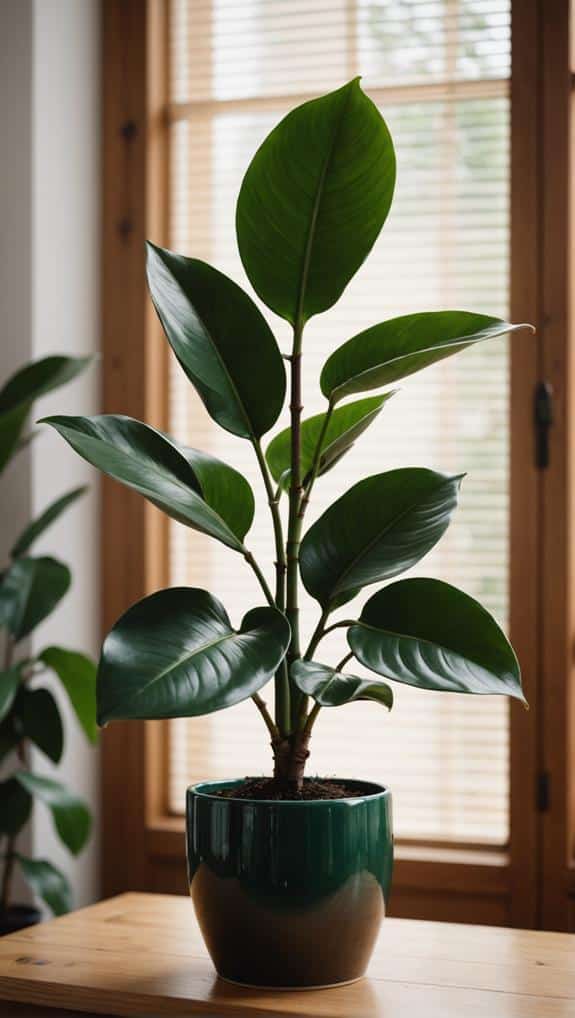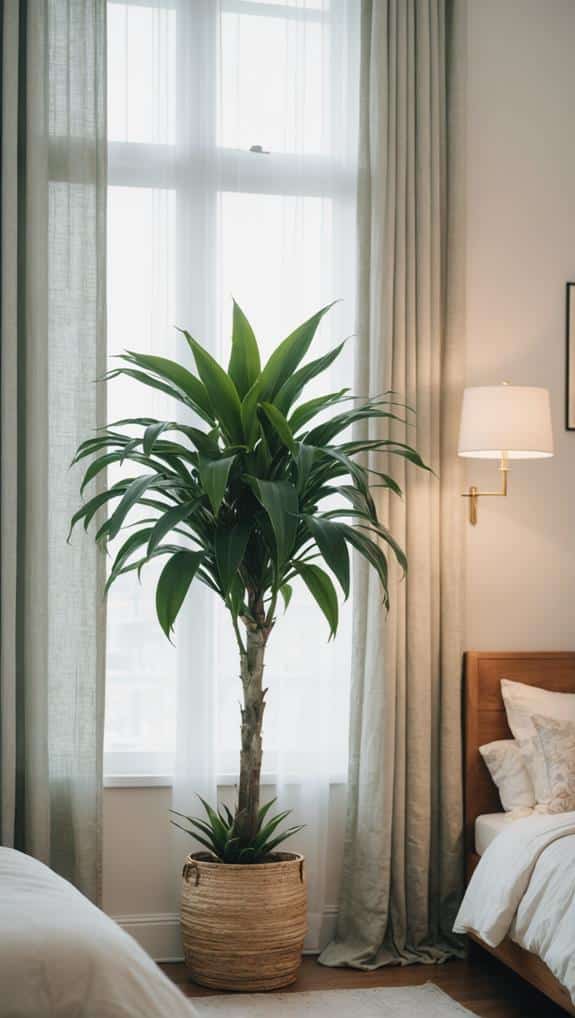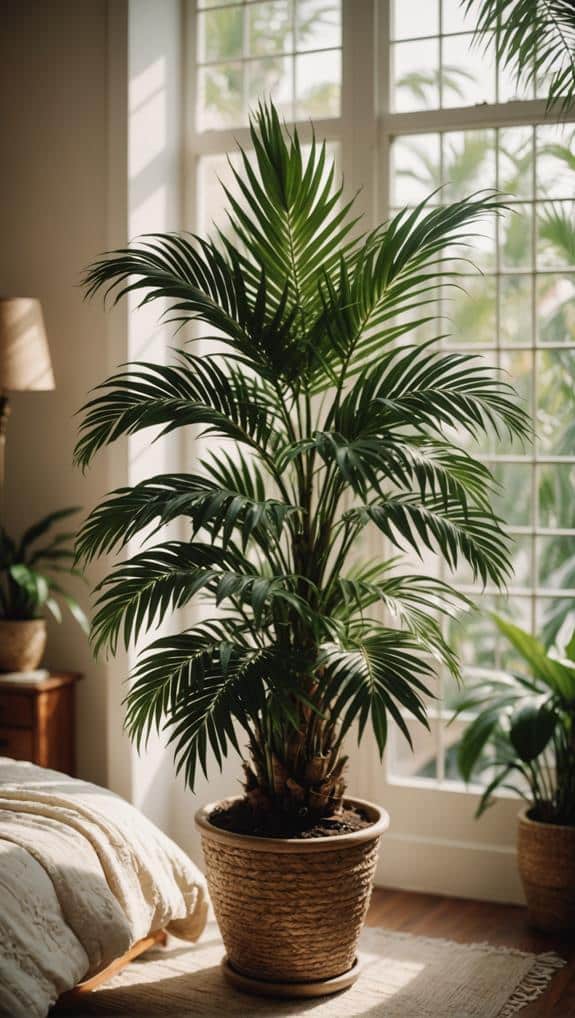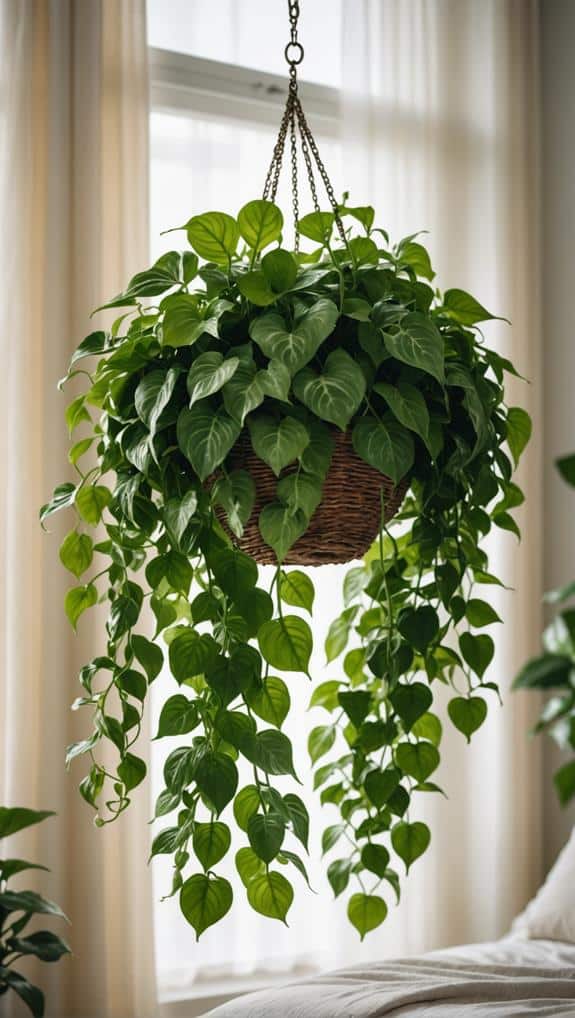At Chic Refuge, as experts in the home decor niche, we believe that enhancing air quality in your bedroom can significantly improve your overall well-being.
Several plants come highly recommended for their air-purifying qualities. The Snake Plant and Peace Lily are standout choices, efficiently filtering toxins while boosting oxygen levels.
Additionally, Spider Plants and Boston Ferns not only purify the air but also bring aesthetic charm to your space. Aloe Vera is particularly useful, as it enhances air quality and provides soothing gel for skin care.
Don’t forget the versatile Dracaena, Areca Palm, ZZ Plant, and Pothos, all of which thrive in various light conditions.
By incorporating these plants, you can transform your bedroom into a healthier retreat.
Looking for even more insights and tips to elevate your home decor?
Key Takeaways
- Snake Plant and Aloe Vera convert CO2 into oxygen at night, promoting better sleep and air quality in bedrooms.
- Peace Lily and Boston Fern effectively remove indoor toxins and improve overall air purity.
- Spider Plant and Pothos require minimal care while enhancing air quality and adding aesthetic appeal to any room.
- Dracaena and Rubber Plant are resilient choices that thrive in indirect light and help reduce harmful indoor pollutants.
- ZZ Plant and Areca Palm not only purify the air but also add tropical flair and beauty to the bedroom decor.
Snake Plant

In our quest for the perfect bedroom plants, the Snake Plant stands out as an ideal choice. Known for its striking vertical leaves, this plant not only adds aesthetics but also offers impressive air purification benefits.
It’s one of the few plants that converts carbon dioxide into oxygen during the night, making it perfect for our sleeping spaces.
Caring for a Snake Plant is incredibly straightforward, which makes it great for both beginners and seasoned plant lovers.
It thrives in a variety of lighting conditions, from low light to bright indirect sunlight. We should water it sparingly—every two to six weeks, depending on the season—and guarantee it drains well to avoid root rot. A well-draining potting mix is essential for snake plant care.
Additionally, it’s a resilient plant that can survive occasional neglect, making it perfect for our busy lifestyles.
A little dusting on the leaves keeps it looking fresh and helps with its ability to filter airborne toxins. By incorporating a Snake Plant into our bedrooms, we not only elevate our decor but also invest in our health, creating a cleaner, more inviting atmosphere.
Peace Lily

The Peace Lily is a stunning addition to any bedroom, bringing both beauty and functionality. This graceful plant not only enhances our space but also purifies the air, making it a favorite among houseplant enthusiasts.
You’ll love providing peace lily care tips, as they’re quite easy to follow.
To fully appreciate what this lovely plant offers, let’s highlight some emotional benefits it brings:
- A calming presence: The soft white blooms create a serene atmosphere.
- Air purification: It effectively removes toxins, promoting a healthier living space.
- Low maintenance: Its forgiving nature makes it perfect for beginners.
- Symbol of peace: It’s often associated with tranquility and harmony.
We should keep a few peace lily care tips in mind to guarantee our plant thrives. Regularly watering it, ensuring indirect sunlight, and wiping its leaves will keep the plant healthy and vibrant.
Beyond aesthetics, the peace lily benefits us by improving indoor air quality, making our bedrooms not just beautiful but healthier too.
Spider Plant

Following the Peace Lily’s calming presence, we now find ourselves enchanted by the Spider Plant, another favorite for bedroom spaces. This resilient green companion is known for its air-purifying capabilities and versatility, making it a great addition to our indoor garden.
One of the most impressive spider plant benefits is its ability to remove pollutants such as formaldehyde and xylene from our environment. Not only does it contribute to cleaner air, but it also adds a lively touch to our space with its arching green leaves and charming baby “pups” that dangle beautifully.
When it comes to spider plant care, we’re in for an easy ride. These plants thrive in a variety of conditions and can tolerate low light, although they flourish in bright, indirect sunlight.
Watering is simple; we should allow the soil to dry out between waterings, as overwatering can lead to root rot. Fertilizing can be done sparingly during the growing season.
With minimal effort, we’re rewarded with a stunning plant that improves our air quality and enliven our personal oasis. The Spider Plant is a delightful choice for anyone seeking to enhance their bedroom atmosphere.
Boston Fern

Bringing the lush, vibrant charm of the Boston Fern into our bedrooms instantly transforms the atmosphere.
This stunning plant not only enhances our décor but also offers numerous benefits for air quality. By choosing a Boston Fern, we invite a calming presence while purifying the air around us.
To guarantee we get the most out of our Boston Fern, let’s remember these key points:
- Natural Air Purifier: It absorbs toxins and adds oxygen, improving our indoor air quality.
- Humidity Booster: This plant helps maintain moisture in the air, which can be beneficial for our skin and respiratory health.
- Low Light Lover: Boston Ferns thrive in indirect light, making them perfect for cozy bedroom corners.
- Aesthetic Appeal: Their lush fronds create a serene atmosphere, turning our spaces into relaxing retreats.
When it comes to Boston fern care, it thrives in humidity and requires consistent watering, ensuring the soil stays moist.
With these simple tips, we can enjoy all the wonderful Boston fern benefits while creating a healthier environment in our bedrooms.
Let’s get started on this journey toward greener living!
Aloe Vera

Aloe Vera is a fantastic addition to our bedroom that combines beauty with practicality. Known for its lush, green leaves and striking appearance, this delightful plant also offers impressive aloe benefits.
One of the most celebrated features of Aloe Vera is its ability to purify the air. It absorbs carbon dioxide at night, converting it into oxygen, which enhances the overall air quality in our sleeping space.
Taking care of Aloe Vera is straightforward, making it perfect for both seasoned and novice plant enthusiasts. It thrives best in bright, indirect sunlight, so choosing a suitable spot on our windowsill can promote its growth.
We should let the soil dry out completely between waterings, as overwatering can lead to root rot. Occasionally, we can wipe the leaves with a damp cloth to remove dust, keeping our plant looking vibrant.
In addition to its air-purifying qualities, we can also tap into its soothing gel. If we ever sustain a minor burn or cut, applying Aloe Vera can provide instant relief.
Rubber Plant

Among the most popular choices for bedroom plants, the Rubber Plant stands out for its impressive size and vibrant green foliage. Known for its air-purifying qualities, this plant not only enhances our bedrooms aesthetically but also contributes to our well-being.
With proper rubber plant care, we can enjoy its many benefits throughout the year. To keep our Rubber Plant thriving, we should keep a few essential tips in mind:
- Regularly check for dust buildup on the leaves to maximize its air-purifying abilities.
- Water when the top few inches of soil are dry, avoiding overwatering to prevent root rot.
- Position it in indirect sunlight to guarantee peak growth and color vibrancy.
- Fertilize during the growing season to provide essential nutrients.
The rubber plant benefits extend beyond its beautiful appearance; it can help reduce harmful indoor pollutants like formaldehyde.
Dracaena

With its striking, arching leaves and minimal care requirements, the Dracaena is an excellent choice for our bedrooms. This versatile plant comes in various dracaena varieties, including the popular Dracaena Marginata and the more compact Dracaena Compacta.
Their unique appearances not only enhance our bedroom decor but also help purify the air, making them a great companion as we sleep.
When it comes to dracaena care, these plants thrive in indirect sunlight, making them perfect for low-light environments.
We should aim to keep the soil consistently moist but not soggy, watering only when the top inch feels dry. An added benefit is their resilience to neglect, allowing us to enjoy their beauty without constant attention.
Regular dusting of the leaves maintains their aesthetic and allows the plant to photosynthesize effectively.
We might also consider repotting every couple of years to refresh the soil mix and give our Dracaena room to grow.
Areca Palm

The Areca Palm, often praised for its feathery fronds and tropical vibes, makes a stunning addition to our bedrooms. Not only does it elevate our decor, but it also provides a range of areca palm benefits that enhance our living space.
This plant is renowned for its air-purifying qualities, effectively filtering indoor toxins and releasing moisture into the air.
When we think of areca palm care, we find it’s quite manageable. It’s essential to place it in bright, indirect light and keep the soil slightly moist, as this tropical beauty thrives in humid conditions.
Here are some reasons we’ll love having an Areca Palm in our bedrooms:
- Creates a serene atmosphere that promotes relaxation.
- Improves air quality, making our space healthier.
- Forms a natural barrier, enhancing privacy.
- Adds vibrant color, brightening even the dullest corners.
With the right care, the Areca Palm can flourish, bringing life and energy to our personal sanctuaries.
Let’s embrace this stunning plant and enjoy both its beauty and the fresh air it provides!
ZZ Plant

If we want to bring a touch of resilience to our bedrooms, the ZZ Plant is an excellent choice. Known for its glossy, attractive leaves, this plant thrives even in low light and requires minimal maintenance, which makes it perfect for busy lifestyles.
One of the standout zz plant benefits is its ability to purify the air by filtering out harmful toxins. This is particularly valuable in bedrooms where we spend a significant amount of time.
In terms of zz plant care, we don’t need to worry too much. It’s drought-tolerant, meaning we can let the soil dry out completely between waterings. Ideally, a good rule of thumb is to water it every two to three weeks, depending on humidity and light conditions.
Fertilizing isn’t necessary often; once or twice a year with a balanced liquid fertilizer should suffice to keep it thriving.
Additionally, the ZZ Plant prefers temperatures between 60-75°F, but it’s quite adaptable to various environments.
When we choose the ZZ Plant for our bedrooms, we’re not just adding beauty; we’re embracing a low-maintenance companion that enhances air quality and supports a healthier living space.
Pothos

Pothos, often adorned with heart-shaped leaves, is a fantastic choice for enriching our bedrooms. This resilient plant doesn’t just look beautiful; it comes with numerous pothos benefits that can enhance our living space. It effectively removes indoor pollutants, purifying the air we breathe while adding a touch of greenery to our decor.
When we think about pothos care, we’ll find it’s wonderfully easy. This plant thrives in various lighting conditions, from low light to bright, indirect light. Plus, it requires minimal watering—just let the topsoil dry out between waterings.
Here’s why we should consider adding this remarkable plant to our bedroom:
- It’s forgiving, making it perfect for those of us new to gardening.
- Its trailing vines can create a relaxing, natural atmosphere.
- Pothos offers a vibrant splash of color, enhancing our room’s aesthetics.
- It can boost our mood and provide a sense of tranquility.
Let’s embrace the beauty and benefits of pothos as we create a more inviting, cleaner environment in our personal spaces. Incorporating this charming plant into our bedrooms can transform our surroundings into soothing sanctuaries.
Frequently Asked Questions
Can Pets Safely Be Around These Bedroom Plants?
In our shared sanctuary, balancing nature and companionship is essential. We’ve researched pet safety thoroughly, and luckily, many popular plants have low toxicity levels, ensuring our furry friends thrive alongside our thriving green companions.
How Can I Propagate These Plants at Home?
When we talk about propagating these plants at home, we can use various propagation methods like water or soil propagation. Taking plant cuttings helps us create new plants that thrive indoors. Let’s get started!
Do These Plants Require Special Soil Types?
These plants typically thrive in well-draining soil that meets their nutrient needs. We’ve found that using a mix designed for houseplants guarantees ideal soil drainage, supporting their growth and overall health in our homes.
What Is the Ideal Humidity Level for These Plants?
We’ve found that ideal humidity levels for plants generally range from 40% to 60%. Understanding humidity effects helps us cater to specific plant preferences, ensuring our greenery thrives in a comfortable environment while we enjoy them.
How Often Should I Rotate the Plants for Even Growth?
We should rotate our plants every couple of weeks to guarantee even light exposure. This practice helps them develop balanced growth patterns, preventing any single side from becoming leggy or undernourished from lack of light.





